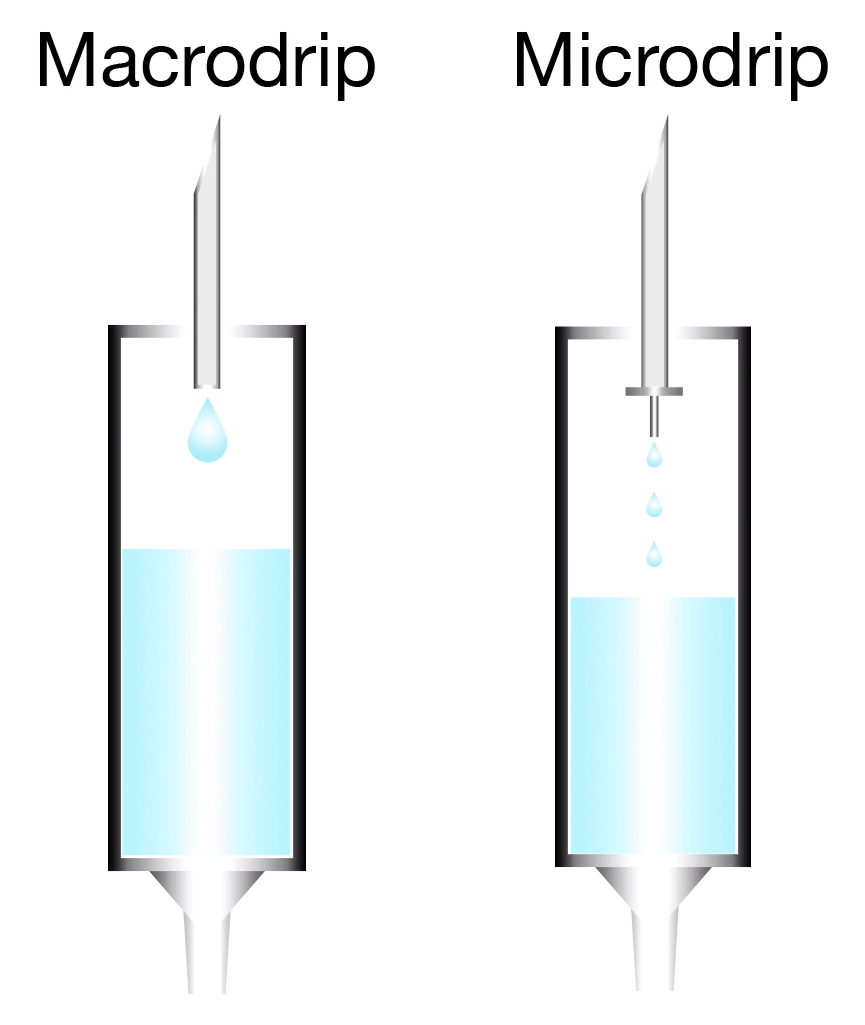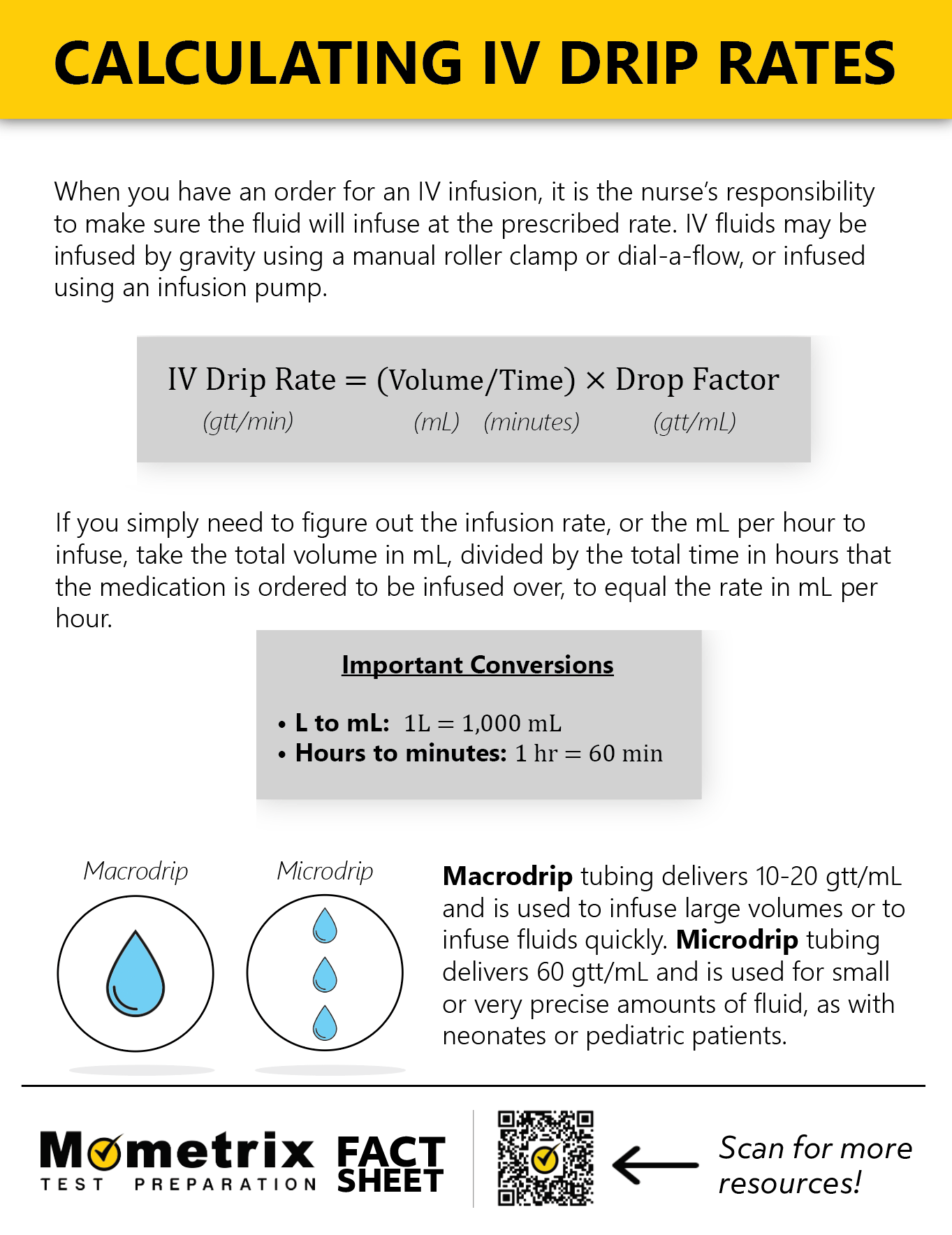at what rate should the iv pump be set to deliver the prescribed rate oof infusion
Calculating 4 Drip Rates
Calculator
Welcome to this video tutorial on computing Iv drip rates. When you have an club for an 4 infusion, it is the nurse'due south responsibility to brand sure the fluid will infuse at the prescribed rate. Iv fluids may be infused by gravity using a manual roller clamp or dial-a-flow, or infused using an infusion pump.
Microdrip and Macrodrip
Regardless of the method, information technology is important to know how to calculate the correct IV flow charge per unit. When calculating the flow rate, determine which Iv tubing you will be using (microdrip or macrodrip), then you tin can use the proper drib gene in your calculations. The drop factor is the number of drops in 1 mL of solution, and is printed on the IV tubing package.
Macrodrip and microdrip refers to the diameter of the needle where the drib enters the drip sleeping room.

Macrodrip tubing delivers 10 to 20 gtts/mL and is used to infuse large volumes or to infuse fluids apace. Microdrip tubing delivers sixty gtts/mL and is used for small or very precise amounts of fluid, equally with neonates or pediatric patients.
If yous simply need to figure out the mL per hour to infuse, take the full book in mL, divided past the total time in hours, to equal the mL per hour. For example, if y'all have 1,000 mL NS to infuse over 8 hours, take 1,000 divided past 8, to equal 125 mL/hr. To calculate the drops per minute, the drib factor is needed. The formula for calculating the Four flow rate (drip rate) is total volume (in mL) divided by time (in min), multiplied by the drib factor (in gtts/mL), which equals the 4 flow rate in gtts/min.
Instance 1
Let's effort an example. The provider has ordered ane,000 mL Lactated Ringers to infuse over viii hours. You have a macrodrip tubing with a drop cistron of 15 gtts/mL. Calculate how many gtts/min to set as the Four period rate.
Using the formula, 1,000 mL divided by 8 times 60 (since we accept 8 hours times lx min/hr), then multiply by 15 gtts/min to equal 31.2, rounded to 31 gtts/min.
Here'south a tip: when the 4 tubing is microdrip, 60 gtts/mL, the drops per min will be the aforementioned equally the mL per hour. For example, you have 500 mL to infuse over 12 hours with a microdrip set. The total volume (500 mL) divided past the total time in hours (12) equals 41.half dozen, rounded to 42 mL per hour. The drops per minute would be calculated as full volume, divided past fourth dimension (in minutes), multiplied past the drop factor of 60 gtts/min, which also equals 41.6, rounded to 42 drops per infinitesimal.
Case two
Let's look at an case of an Iv piggyback medication.
Ancef one gm in 100 mL normal saline to be infused over 30 minutes. You lot take macrodrip tubing with a driblet factor of 10 gtts/mL. Calculate how many gtts/min to fix as the Iv flow rate.
Use the formula, with 100 mL divided by 30 min, multiplied by 10 gtts/min, which equals 33.3, rounded to 33 gtts/min. If you demand to set this up on an 4 infusion pump, use the formula, volume (mL) divided past time (min), multiplied by threescore min over one 60 minutes, this equals the IV period rate in mL/hour. Using this formula, 100 mL divided by 30 min, times sixty min in one hour, equals 199.9, rounded to 200 mL/hr.
Once the infusion has started, monitor closely to be sure it is infusing at the correct rate and bank check the patient's IV site for signs of infiltration or inflammation.
Thanks for watching this video about computing IV drip rates!
Frequently Asked Questions
Q
What is an 4 baste charge per unit?
A
An IV drip rate is a way of describing the rate of an intravenous infusion based on the number of drops (gtt) that are administered to the patient per minute. This is influenced past the type of the tubing (microdrip or macrodrip), the total book that is required to be infused, and the time over which the infusion is ordered to run.
Q
What is an IV drop cistron?
A
An Iv driblet factor reflects the specific size of the drops of 4 fluid that the tubing set creates. This is a predetermined number based on the tubing required and available to administer the medication. Tubing can be either microdrip or macrodrip.
Q
What is the divergence between a microdrip and macrodrip Iv tubing?
A
Microdrip IV tubing creates extremely pocket-sized drip sizes for medications that are potent and must be carefully administered and/or for patient populations that are highly sensitive to large doses of medications (namely, neonatal and pediatric patients). The microdrip baste factor is generally estimated at 60 gtt/mL.
Macrodrip Iv tubing is the more standard tubing type, and has larger drops of fluid than microdrip tubing. The macrodrip baste cistron is generally somewhere betwixt x to 20 gtt/mL.
Q
How do you calculate an Iv drip charge per unit?
A
Four baste rate is calculated by this simple formula: IV Drip Charge per unit (gtt/min) = Total Volume (mL)/Time (min) x Drop Factor (gtt/mL)
This equation can likewise be rearranged to calculate the fourth dimension required for an infusion, when provided the book to be infused, the baste rate, and the drop factor.
Critical to perform prior to completing this formula is any conversions required, such as fluid volume provided in liters converted to milliliters, or fourth dimension for infusion provided in hours converted to minutes.
Fact Canvas

Return to Patient Care Videos
396112 278763
Source: https://www.mometrix.com/academy/calculations-of-drip-rates/
Post a Comment for "at what rate should the iv pump be set to deliver the prescribed rate oof infusion"